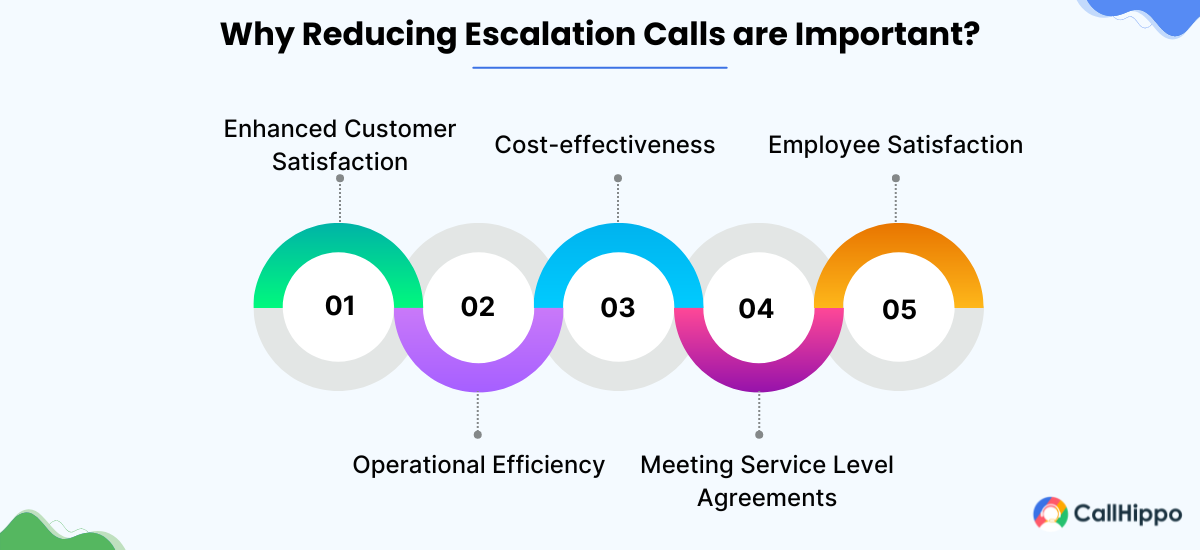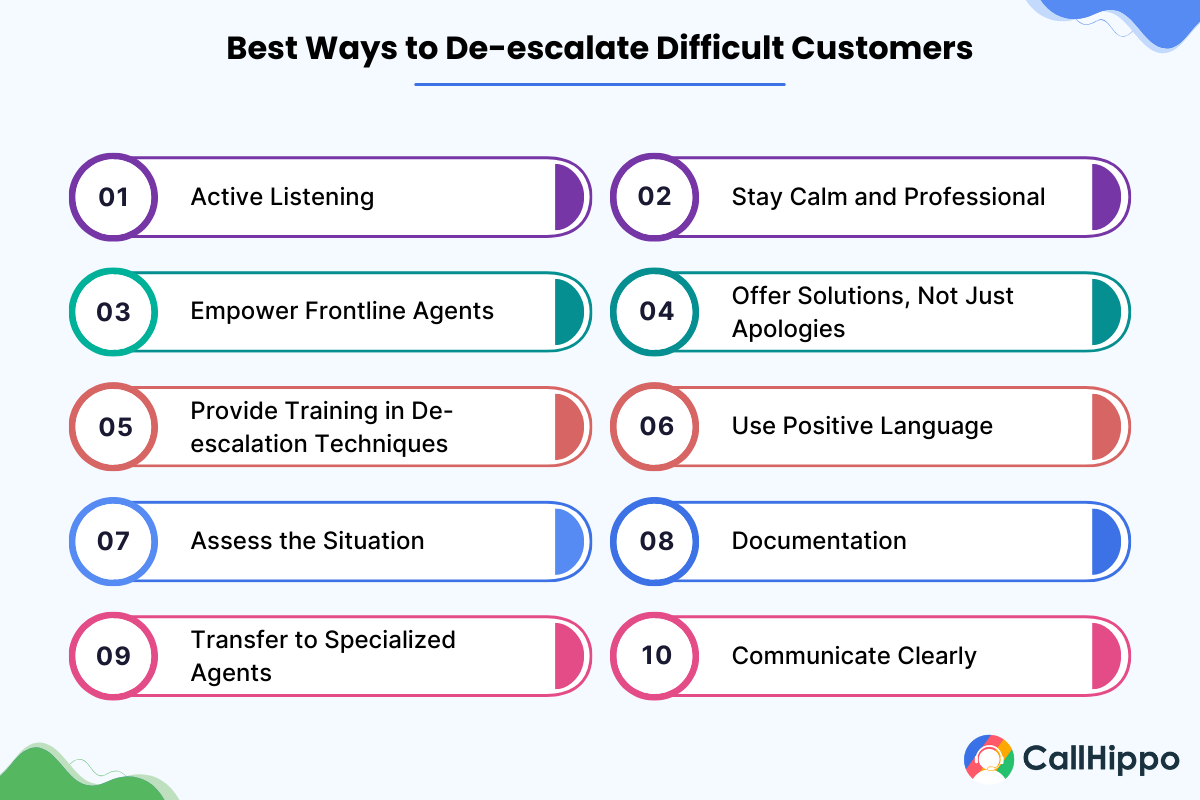Call centers play a pivotal role in ensuring a seamless communication channel between businesses and their clients. One essential aspect of call center operations is call escalation, a process designed to efficiently resolve customer issues that cannot be addressed at the initial support level.
Mororeover, the average call escalation rate is 10%, which should be reduced if companies want to offer better customer support. In this blog post, we will delve into the concept of call escalation, its importance, and the various types that exist in the dynamic landscape of customer support.
What is a Call Escalation in a Call Center?
A call escalation in a call center refers to the process of transferring a customer’s inquiry or concern from an initial support agent to a higher level of expertise or authority within the organization. This transfer occurs when the initial agent is unable to satisfactorily address the complexity or nature of the customer’s issue.
The primary objective of call escalation is to ensure that more challenging problems receive specialized attention and expertise, leading to a prompt and effective resolution. This strategic approach helps optimize resource allocation, adhere to service level agreements, and ultimately enhance customer satisfaction by providing tailored solutions to intricate concerns.
When handling call escalations in a call center, prioritize active listening and empathetic communication. Understand the customer's perspective, work collaboratively with specialized teams, and always strive for a timely resolution to ensure a positive customer experience.
What are the Different Types of Call Escalation?
There are several types of call escalation in a call center, each designed to address specific aspects of customer issues. The main types include
1. Technical Escalation
This involves transferring a call to a higher-tier support agent with specialized technical knowledge. Technical escalations are common for issues related to software, hardware, or any other technical aspects of a product or service.
2. Supervisor Escalation
When an initial support agent is unable to resolve a customer issue, the call may be escalated to a supervisor or team leader. Supervisor escalation is often used for more complex problems or when additional authority is needed to address a customer’s concerns.
3. Departmental Escalation
In cases where the issue spans multiple departments or requires collaboration from different teams, a departmental escalation may occur. This ensures that the problem is addressed comprehensively, involving the expertise of various departments within the organization.
4. Managerial Escalation
For escalated issues that require a higher level of decision-making or authorization, managerial escalation comes into play. This involves routing the call to a higher-ranking manager who has the authority to make crucial decisions to resolve the customer’s problem.
Top 5 Importance of Reducing Escalation Calls
Call center escalation occur when customer issues surpass the capabilities of frontline call center agents, requiring intervention from higher-tier support or management. The significance of minimizing such escalations extends to various aspects of call center operations:

1. Enhanced Customer Satisfaction
Timely resolution of issues at the initial support level directly contributes to customer satisfaction. By minimizing escalations, call centers can ensure that customers’ concerns are addressed promptly and efficiently, fostering positive experiences.
2. Operational Efficiency
Reducing escalation calls optimizes the allocation of resources. By resolving issues at the frontline, call centers can streamline workflows, manage workloads more effectively, and ensure that specialized support is reserved for truly complex problems.
3. Cost-effectiveness
Escalation calls often demand higher-level expertise and resources, leading to increased operational costs. Minimizing these escalations helps control expenses and allows call centers to allocate resources judiciously, focusing on providing efficient support without unnecessary overheads.
4. Meeting Service Level Agreements (SLAs)
Call centers typically operate under SLAs, which outline response and resolution times for customer inquiries. Reducing escalation calls ensures that these SLAs are met consistently, reinforcing the call center’s commitment to delivering timely and quality service.
5. Employee Satisfaction
Frequent escalations can contribute to agent stress and burnout. By empowering frontline agents to effectively handle and resolve customer issues, the workload is distributed more evenly, promoting a positive working environment and reducing employee turnover.
10 Best Ways to De-escalate Difficult Customers
Dealing with difficult customers is an inevitable part of customer service, but adept call center de-escalation techniques can turn challenging situations into positive interactions. Here are some effective strategies for de-escalating difficult customers:

1. Active Listening
Demonstrating empathy and understanding by actively listening to the customer’s concerns can diffuse tension. Acknowledge their feelings, repeat key points, and assure them that their issue is being addressed.
2. Stay Calm and Professional
Maintain a calm and professional demeanor, regardless of the customer’s tone. Responding with composure helps to de-escalate the situation and promotes a more constructive dialogue.
3. Empower Frontline Agents
Provide frontline agents with the authority and tools to resolve common issues promptly. Empowering agents to take ownership of problems can prevent unnecessary escalations and build confidence in customer interactions.
4. Offer Solutions, Not Just Apologies
Instead of solely apologizing, present actionable solutions to the customer’s problem. Offering a resolution demonstrates a commitment to problem-solving, which can positively impact the customer’s perception.
5. Provide Training in De-escalation Techniques
Equip frontline agents with training in de-escalation techniques. This includes communication skills, conflict resolution strategies, and the ability to navigate challenging conversations effectively.
6. Use Positive Language
Choose positive and reassuring language when communicating with customers. Frame responses in a way that emphasizes solutions and cooperation rather than focusing on the issues at hand.
7. Assess the Situation
Evaluate the nature and complexity of the customer’s issue before handling escalated calls. Determine whether the escalation is necessary or if it can be resolved at the current level. Understanding the context is crucial for providing an appropriate solution.
8. Documentation
Document all relevant information regarding the escalation, including the customer’s concerns, previous interactions, and any steps taken to address the issue. This documentation aids in providing a seamless handover to the higher-level support.
9. Transfer to Specialized Agents
If the issue requires specialized knowledge or technical expertise, transfer the call to a higher-tier support agent or a specialist who can effectively address the customer’s concerns. Ensure a smooth transition and provide context to the receiving agent.
10. Communicate Clearly
Clearly communicate to the customer that their issue is being escalated for more specialized assistance. Provide information on the expected resolution time and assure them that their concern is a priority.
16 Call Escalation Script Template for Managers
Creating a call escalation script for managers is crucial to ensure consistency, efficiency, and professionalism when addressing escalated customer issues. Below is a template you can use as a foundation for your call escalation script:
1. Introduction
Manager: “Thank you for reaching out to us. My name is [Manager’s Name], and I’m a [Position] here at [Company Name]. I understand that you have a concern that requires special attention. I’m here to assist you.”
2. Empathize
Manager: “I appreciate your patience, and I want to assure you that we take your concerns seriously. I’m here to help find a resolution for you.”
3. Acknowledge the Issue
Manager: “I understand that the matter you’re facing is important, and I want to assure you that we are committed to resolving it to your satisfaction.”
4. Briefly Explain the Escalation Process
Manager: “To address your concern effectively, I will be taking ownership of the matter and working closely with our specialized team to find a resolution. This may involve additional expertise to ensure we provide the best solution for you.”
5. Obtain Additional Information (if needed)
Manager: “Before we proceed, could you please provide any additional details or specific information related to your concern? This will help us expedite the resolution process.”
6. Set Expectations
Manager: “I want to be transparent with you. Resolving this matter may take some time, but I’ll do my best to keep you informed throughout the process. Is there a preferred method of communication for updates?”
7. Reassure and Offer Apology
Manager: “I sincerely apologize for any inconvenience this has caused you. Your satisfaction is our priority, and we are committed to making things right.”
8. Confirm Contact Information
Manager: “To ensure we can reach you with updates, can you please confirm the best phone number or email to reach you?”
9. Thank the Customer
Manager: “Thank you for bringing this matter to our attention. Your feedback is valuable, and we are dedicated to resolving this in a timely and satisfactory manner.”
10. Closing Statement
Manager: “Rest assured, I will personally oversee the resolution of your concern. If you have any further questions or if there’s anything else I can assist you with, please feel free to let me know.”
11. Document the Escalation
Manager: “I’ll be documenting the details of our conversation and ensuring a seamless handover to the appropriate team. Your case is a priority for us.”
12. Provide Escalation Reference Number (if applicable)
Manager: “For your reference, I’ll provide you with an escalation number. This will help us track the progress of your case. Please note [provide the reference number].”
13. Express Gratitude
Manager: “Thank you for your understanding, [Customer’s Name]. We appreciate your patience, and we are committed to resolving this matter to your satisfaction.”
14. Confirm Next Steps
Manager: “I will personally follow up with you within [specified time frame] with an update. In the meantime, if you have any concerns or questions, please don’t hesitate to reach out.”
15. Closing Formalities
Manager: “Once again, thank you for choosing [Company Name]. We value your business, and I’m here to ensure your experience is a positive one.”
16. Closing Greeting
Manager: “Have a great day, [Customer’s Name], and thank you for giving us the opportunity to address your concerns.”
Feel free to customize this script based on your company’s tone, policies, and specific customer service requirements.
Conclusion
A well-crafted call escalation process, coupled with continuous training and feedback mechanisms, contributes to enhanced customer satisfaction, operational efficiency, and the overall success of the call center. Remember, a proactive and customer-focused approach during escalations not only resolves immediate issues but also strengthens the customer-agent relationship, fostering trust and loyalty over time.
Frequently asked questions
1. What is an example of a call escalation?
A customer contacts a call center with a technical issue that the frontline agent cannot resolve. The call is escalated to a higher-tier support agent with specialized technical knowledge for a more in-depth solution.
2. What is the escalation rate in a call center?
The escalation rate in a call center is the percentage of customer inquiries or issues that require transfer to a higher level of support. It is calculated by dividing the number of escalated calls by the total number of incoming calls and multiplying by 100 to get the percentage.
3. Why do calls escalate?
Calls escalate when frontline agents are unable to resolve complex issues or when additional expertise, authorization, or resources are needed. Common reasons include technical challenges, the need for managerial approval, or problems that span multiple departments.
4. What are the 3 stages of escalation?
The three stages of escalation typically involve:
a. Frontline Resolution: Initial attempt to address the customer’s concern by the frontline agent.
b. Specialized Support: Transfer to a higher-tier support agent or a specialized team for more in-depth assistance.
c. Managerial Involvement: Escalation to a manager or higher authority for resolution, especially when decisions or approvals beyond the agent’s scope are required.

Subscribe to our newsletter & never miss our latest news and promotions.









